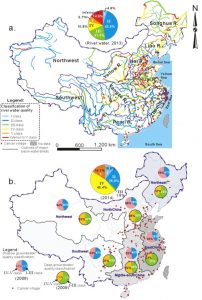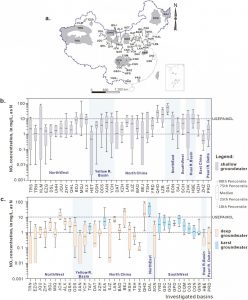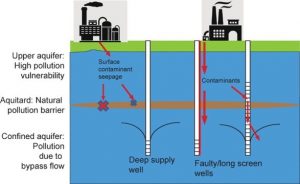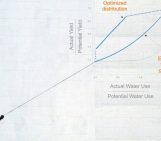
by Matthew Currell, School of Engineering, RMIT University, Australia
As part of its recent ‘war on pollution’, the Chinese Central Government released a major policy on water pollution control and clean-up, called the ‘10-point water plan’ in 2015. The plan aims to deal once and for all with China’s chronic water quality problems. China’s water quality deficiencies became widely recognised around the turn of the millennium, following publication of seminal works by Ma Jun, Elizabeth Economy and other local and overseas environmental campaigners. It is now widely acknowledged that chronic exposure to water pollution in China has contributed to the emergence of hundreds of cancer villages, where rates of particular types of cancer that are linked to water pollution far exceed normal population-wide averages. In addition to agricultural pollution and domestic wastewater, in many regions the pollution has resulted from industries that are part of multi-national supply chains, meaning international factors have played an important role.
In a recent review paper published in Environmental Pollution, my colleague Dongmei Han and I compiled data from official Chinese government reports to provide a snapshot of the current status of water quality in China’s major river basins, coastal waters and groundwater systems, including shallow unconfined and deeper confined aquifers (Figure 1). The results are sobering, showing that despite some recent progress, about a third of China’s river monitoring stations and more than 60% of sampled groundwater wells are seriously polluted. These data agree with an internal Ministry of Water Resources report that was briefly made public in early 2016, which showed that more than 80% of the more than 2000 monitored shallow groundwater wells in northern China’s plains areas contain serious pollution and that the aquifers they monitor are unfit to supply drinking water.

Figure 1 – Status of water quality in China based on recent government statistics. a) Surface water, ranked according to the 6-class water quality classification standard. b) Groundwater, ranked using the 5-class system in 6 sub-areas of China, including shallow and deep groundwater. Overall percentages of sampled stations/wells in each water quality class are shown as large pie-charts; percentages in yellow and red on small pie-charts indicate proportion of samples in the lowest two classes (IV & V) for shallow and deep groundwater, respectively. Both maps have been overlain with the locations of known ‘cancer villages’.
In addition to the government data, we also targeted the research literature and compiled as many datasets as possible reporting concentrations of nitrate in shallow and/or deep aquifers throughout China. Compiling these data from over 70 different sources provides greater local detail about the severity of groundwater pollution (Figure 2). We chose nitrate as an ‘indicator pollutant’ because it is widely measured, easy to detect and highly water-soluble. The presence of nitrate in a sample is often an indicator that other pollutants may also be there. The results indicate that all shallow aquifers sampled contain nitrate above the typical natural background level (approximately 1 mg/L nitrate-N or 4.5 mg/L nitrate as NO3– ion), indicating some degree of pollution. Of these 36 aquifers, samples from 25 contained nitrate concentrations exceeding the US EPA maximum contaminant level (MCL) of 10 mg/L nitrate-N. Worryingly, all but one of 37 deep or karst aquifers examined contained nitrate above the background level, while 10 of these aquifers had samples above the MCL. In five of the shallow aquifers and four of the deep aquifers, median nitrate concentrations also exceeded the MCL, meaning half of all wells in the aquifer pump groundwater with nitrate levels exceeding the maximum safe level. We also compiled groundwater stable nitrogen isotope values of the nitrate where they were available. These isotope data help to identify the major sources of nitrate pollution such as chemical fertilizers, soil nitrogen, manure and domestic wastewater, as each potential source can have a unique isotope ‘signature’. Nitrogen isotopes can also provide evidence of microbes breaking down pollution; this is important when considering whether the nitrate will naturally degrade, or if engineered clean-up strategies are required.

Figure 2 – Nitrate concentrations in groundwater from major groundwater systems in China: a) Location map of the 52 study areas from which data were compiled; b) & c) Boxplot distributions of nitrate concentrations (as N) in shallow and deep groundwater throughout China. Boxplots show median, inter-quartile range and 10th and 90th percentile values. Data is compared to the United States Environmental Protection Agency maximum contaminant level (10 mg/L) and a background concentration of 1 mg/L Nitrate-N (equivalent to approximately 4.5 mg/L nitrate as NO3- ion).
Perhaps the issue of greatest concern from our review was the observation that in addition to being ubiquitous in shallow groundwater (as is perhaps expected in areas of intensive agriculture or wastewater pollution), nitrate pollution also frequently appears in deep wells (drilled to >100m below the surface) throughout China. Normally, the time taken for water to reach these confined aquifers is long, and much of the deep groundwater in China has been dated using radio-isotopes, which indicate that it was recharged thousands or tens of thousands of years before the present. The presence of nitrate above natural background levels in these groundwater bodies suggests that pollution is undergoing rapid ‘bypass flow’ (e.g. taking short-cuts) from the surface into deep aquifers.
The Chinese Ministry of Water Resources has made public statements indicating it believes that China’s deep aquifers are safe drinking water sources, isolated from surface pollution effects due to natural geological barriers (called ‘aquitards’ by hydrogeologists). However, our data call into question this assumption. A similar finding was recently made by a group at the Chinese Academy of Sciences, who conducted a geochemical survey of tap water from various sites around Beijing. Most of Beijing’s water supply plants pump from deep groundwater wells around the city. The survey found that a significant number of samples contained nitrate and other pollutants, consistent with our findings that contamination is reaching deep aquifers through short-cut pathways. The most likely explanation is that polluted water is flowing from shallow depths down preferential conduits, such as poorly constructed or badly maintained wells, and bypassing natural geological barriers (Figure 3).
It is estimated that over 4 million wells have been drilled in China’s northern plains alone since the groundwater boom of the 1960s and 1970s. However, only a fraction of these are registered with the government or maintained. Clearly, a program to identify and plug leaking and abandoned wells is needed to stop further pollution of China’s precious deep groundwater reserves.

Figure 3 – Mechanism by which faulty wells can allow shallow contaminants to bypass into deep aquifers, compromising water supply safety. China has millions of unregistered wells that may act in this way, and depends on deep aquifers for much of its drinking water.
We hope that our research highlights the scale of China’s water pollution challenges, and can help the public and policy makers better understand the extent and mechanisms of groundwater pollution – a problem which is causing serious human health effects. While addressing the problem of pollution in deep aquifers will be difficult, it is too important a task to ignore, as these aquifers supply drinking water to millions of Chinese people.
References & Further reading
Currell, M.J., Han, D., Chen, Z., Cartwright, I. (2012). Sustainability of groundwater usage in northern China: dependence on palaeowaters and effects on water quality, quantity and ecosystem health. Hydrological Processes 26: 4050-4066.
Currell, M.J., Han, D. (2017). The Global Drain: Why China’s water pollution problems should matter to the rest of the world. Environment: Science and Policy for Sustainable Development 59: 16-29. http://dx.doi.org/10.1080/00139157.2017.1252605
Han, D., Currell, M.J., Cao, G. (2016). Deep challenges for China’s war on water pollution. Environmental Pollution 218: 1222-1233. http://www.sciencedirect.com/science/article/pii/S0269749116310363
Peters, M., Guo Q., Strauss, H., Zhu, G. Geochemical and multiple stable isotope (N, O, S) investigation on tap and bottled water from Beijing, China. Journal of Geochemical Exploration 157: 36-51. http://www.sciencedirect.com/science/article/pii/S0375674215300030





kamal mondal
very good informative post.
Pingback: The crisis that could end China's story: Water scarcity - The BL